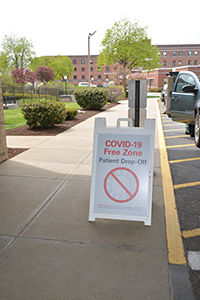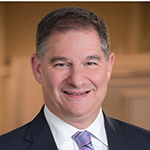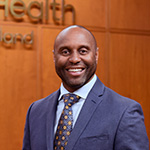By NANCY FOWLER
May 27, 2020

Signage at Mercy Medical Center in Springfield, Massachusetts, reassures patients who do not have COVID-19 symptoms that care is being taken to prevent contagion.
About three months ago, health care organizations began scrambling to transform their day-to-day operations to limit the spread of COVID-19. Health systems are scheduling elective procedures cancelled in the early months of the pandemic, but some changes that were designed to safeguard patients, caregivers and the public may be here to stay. Now, hospitals have to figure out how to pay for them.
Like most health care systems, Trinity Health has established robust safety protocols and revamped its facilities to allow for social distancing and the separation of patients with coronavirus from the general patient population. The Livonia, Michigan-based ministry, which operates 92 hospitals and 106 continuing care facilities in 22 states, has established protocols for screening and testing and established COVID-free zones to protect patients from contagion. It has paid the scarcity premium to acquire personal protective equipment for its caregivers.
Early this month, in a letter to President Donald Trump, Trinity Health's top leaders outlined the effort and expense — tens of millions of dollars so far — that went into meeting the challenges of the pandemic. Trinity Health President and Chief Executive Mike Slubowski and Chairman David Southwell wrote: "The coronavirus pandemic has been brutal for the health care delivery system."
"Trinity Health … has responded with sweeping cost-savings measures that include workforce and salary reductions, suspension of almost all capital spend, and a pause on several strategic initiatives. Unfortunately, we cannot cut our way out of this crisis and still offer the vital services our communities need," the letter elaborated.
The long game
Given these realities, the way forward is fiscally fraught and will require a tedious balancing act, according to Dr. Daniel Roth, Trinity Heath's executive vice president and chief clinical officer.

Roth
"How do we now make sure that we're providing care to people with COVID-19 — because we believe that it's going to be with us for the foreseeable future — while we also provide care for people with all the other medical issues?" Roth said.
Patients entering Trinity Health facilities are immediately screened for COVID-19 symptoms. Those with fever and upper respiratory infection are sent to newly established "FURI" clinics, short for fever, upper respiratory illness clinics. The clinics are located within existing outpatient facilities.
Minimizing the time patients spend in waiting rooms further mitigates the risk of contagion. Patients are routinely instructed to wait outside the facility, on the grounds or in their cars, until they receive an email or text that it's their turn. Everyone — patients and providers — wears a mask. These procedures will remain in place as long as the coronavirus is a concern. Roth predicts reliable treatment for COVID-19 won't be available until later this year and that a vaccine is likely a year away.

Eadie
Keep your distance
Even after a vaccine is being widely administered and COVID-19 is no longer an imminent threat, social distancing will remain the norm and other changes in health care delivery will become permanent, according to Dr. Reginald Eadie, president and chief executive officer of Trinity Health of New England, which oversees the organization's Connecticut and Massachusetts facilities. Eadie compared the expected longevity of social distancing protocols to the ramped-up airport security that remains nearly two decades after the attack on the World Trade Center. People got used to it.
"I think this is going to be the same, with some of the COVID-19 activities lingering for the rest of our lives," Eadie said.
Back to the future
One pandemic-related development that Eadie said won't go away is the wide use of telehealth.
"Millennials are the largest population in our country, and they're going to expect us to continue to be invested in virtual care," Eadie said. "And that allows all Americans to maintain some degree of social distancing."
But virtual visits can only continue as a significant part of operations if providers can keep billing for online appointments under new pandemic-era payment structures, Trinity Health leaders said.
Thirty-four percent of the system's medical visits now involve patients welcoming doctors and nurses into their homes through phones and computers, with providers often conducting these visits from their own homes, outside of medical settings. It's a situation that reminds Eadie of how medical care looked in days gone by.
"It's sort of like a back to the future, back to the '30s, when the physicians had a black bag and came to the patients," Eadie said. "The same thing is happening now — but through technology."
Banking on virtual care
Trinity Health hospitals are getting ready for the next big test: a surge of patients who've been putting off care since the pandemic began. System leaders predict a recent marketing blitz reassuring the community about safety will bring the patients back. A recent study of system-wide data indicates that concerns about exposure to the coronavirus have had a significant downward impact on hospital visits.
The research, which compared a one-month period between March 15 and April 15 in 2019 and again in 2020, found that emergency room patient volumes were down 43 percent year over year. In contrast to last year, Trinity treated nearly 48 percent fewer heart attacks, 43 percent fewer strokes and 72 percent fewer cases of appendicitis.
"That is astonishing to me," Eadie said. "Where are these people and what happened to the disease? These are the questions we have to ask."
Fewer patients has meant less revenue at a time of escalating expenses. The unplanned cost of acquiring massive amounts of protective equipment is one documentable expense. Others are trickier to measure, such as the inefficiencies within the system created by social distancing.
Even large health care systems like Trinity Health will need help absorbing these expenses, Roth and Eadie acknowledged.
"In order to be sustainable, ongoing support from the government will be necessary to cover these costs," Roth said. "The work that we're doing now, is how to make sure that we can sustain our ministry while we operate like this."
"We're continually trying to understand how to be the phoenix rising out of this pandemic," Eadie said.
One potential for controlling operating costs could stem from the rise in telehealth visits. Eadie said that if the increase in virtual visits reduces the need for brick-and-mortar facilities, building and maintenance costs could decline.
"If virtual care is going to be the primary method of providing care in the United States of America, we will be just fine," Eadie said. "We're sort of banking on that."
The essentials of a health care economy
The letter sent by Trinity Health's top executives to President Donald Trump early this month sets out three health care centric tenets for rebuilding a strong national economy:
- The health care delivery system is essential to the broader economic recovery
- Rebuilding the health care economy will take time and require a laser like focus on safety and patient concerns
- The rebuilt health care delivery system must be able to pivot quickly to changing health care imperatives